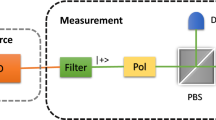Abstract
Considering imperfect experimental conditions, here we give a practical proposal on the decoy-state quantum random number generator with weak coherent sources. In the proposal, three different intensities of light sources are used to estimate the contribution of single-photon pulses. System randomness is characterized and simulated through the minimum entropy. Numerical simulation results show that our new scheme can extract out randomness close to the asymptotic case where the fraction of single-photon pulses are exactly known. Furthermore, a proof-of-principle experimental demonstration is presented, showing excellent agreement between experiment and theory.




Similar content being viewed by others
References
Schneier, B.: Applied Cryptography, 2nd edn. Wiley, New York (1996)
Herrero-Collantes, M., Garcia-Escartin, J.C.: Quantum random number generators. Rev. Mod. Phys. 89, 015004 (2017)
Rarity, J., Owens, P., Tapster, P.: Quantum random-number generation and key sharing. J. Mod. Opt. 41, 2435 (1994)
Stefanov, A., Gisin, N., Guinnard, O., Guinnard, L., Zbinden, H.: Optical quantum random number generator. J. Mod. Opt. 47, 595 (2000)
Jennewein, T., Achleitner, U., Weihs, G., Weinfurter, H., Zeilinger, A.: A fast and compact quantum random number generator. Rev. Sci. Instrum. 71, 1675 (2000)
Dynes, J.F., Yuan, Z.L., Sharpe, A.W., Shields, A.J.: A high speed, postprocessing free, quantum random number generator. Appl. Phys. Lett. 93, 031109 (2008)
Wahl, M., Leifgen, M.: An ultrafast quantum random number generator with provably bounded output bias based on photon arrival time measurements. Appl. Phys. Lett. 98, 171105 (2011)
Nie, Y.Q., Zhang, H.F., Zhang, Z., Wang, J., Ma, X., Zhang, J., Pan, J.W.: Practical and fast quantum random number generation based on photon arrival time relative to external reference. Appl. Phys. Lett. 104, 051110 (2014)
Rogina, B.M.: Quantum random number generator based on photonic emission in semiconductors. Rev. Sci. Instrum. 78, 045104 (2007)
Boweles, J., Quintino, M.T., Brunner, N.: Certifying the dimension of classical and quantum systems in a prepare-and-measure scenario with independent devices. Phys. Rev. Lett. 112, 140407 (2014)
Hwang, W.Y.: Quantum key distribution with high loss: toward global secure communication. Phys. Rev. Lett. 91, 057901 (2003)
Wang, X.B.: Beating the photon-number-splitting attack in practical quantum cryptography. Phys. Rev. Lett. 94, 230503 (2005)
Lo, H.K., Ma, X., Chen, K.: Decoy state quantum key distribution. Phys. Rev. Lett. 94, 230504 (2005)
Wang, C., Song, X.T., Yin, Z.Q., Wang, S., Chen, W., Zhang, C.M., Guo, G.C., Han, Z.F.: Phasereference-free experiment of measurement-device-independent quantum key distribution. Phys. Rev. Lett. 115, 160502 (2015)
Wang, D., Li, M., Guo, G.C., Wang, Q.: An improved scheme on decoy-state method of measurement device-independent quantum key distribution. Sci. Rep. 5, 15130 (2015)
Lunghi, T., Brask, J.B., Bowles, J.: Self-testing quantum random number generator. Phys. Rev. Lett. 114, 150501 (2015)
Konig, R., Renner, R., Schaffner, C.: The operational meaning of min- and max-entropy. IEEE Trans. Inf. Theory 55, 4337 (2009)
Wang, Q., Wang, X.B., Guo, G.C.: Practical decoy-state method in quantum key distribution with a heralded single-photon source. Phys. Rev. A 75, 012312 (2007)
Mao, C.C., Li, J., Zhu, J.R., Zhang, C.M., Wang, Q.: An improved proposal on the practical quantum key distribution with biased basis. Quantum Inf. Process 16, 256 (2017)
Yu, Z.W., Zhou, Y.H., Wang, X.B.: Statistical fluctuation analysis for measurement-device-independent quantum key distribution with three-intensity decoy-state method. Phys. Rev. A 91, 032318 (2015)
Bennett, C.H., Brassard, G.: Quantum cryptography: public key distribution and coin tossing. Theor. Comput. Sci. 560, 7 (2014)
Li, D.D., Gao, S., Li, G.C., Xue, L., Wang, L.W., Lu, C.B.: Field implementation of long-distance quantum key distribution over aerial fiber with fast polarization feedback. Opt. Express 26, 22793 (2018)
Fei, X.W., Yin, Z.Q., Cui, C.H., Huang, W., Xu, B.J., Wang, S., Chen, W., Han, Y.G., Guo, G.C., Han, Z.F.: Optimality of quantum randomness certification with independent devices. J. Opt. Soc. Am. B 35, 2186 (2018)
Fei, X.W., Yin, Z.Q., Huang, W., Xu, B.J., Wang, S., Chen, W., Han, Y.G., Guo, G.C., Han, Z.F.: Tighter bound of quantum randomness certification for independent-devices scenario. Sci. Rep. 7(1), 14666 (2017)
Frohlich, B., Lucamarini, M., Dynes, J.F., Comandar, L.C., Tam, W.W.S., Plews, A., Sharpe, A.W., Yuan, Z.L., Shields, A.J.: Long-distance quantum key distribution secure against coherent attacks”. Optica 4, 163 (2017)
Ding, H.J., Liu, J.Y., Zhang, C.H., Wang, Q.: Predicting optimal parameters with random forest for quantum key distribution. Quantum Inf. Process 19, 60 (2020)
Ding, H.J., Chen, J.J., Ji, L., Zhou, X.Y., Zhang, C.H., Zhang, C.M., Wang, Q.: 280-km experimental demonstration of a quantum digital signature with one decoy state. Opt. Lett. 45, 1711 (2020)
Liu, J.Y., Ding, H.J., Zhang, C.M., Xie, S.P., Wang, Q.: Practical phase-modulation stabilization in quantum key distribution via machine learning. Phys. Rev. Appl. 12, 014059 (2019)
Acknowledgements
We gratefully acknowledge the financial support from the National Key R&D Program of China through Grant Nos. 2018YFA0306400, 2017YFA0304100, the National Natural Science Foundation of China through Grants Nos. 11774180, 61590932 61705110 and the Leading-edge technology Program of Jiangsu Natural Science Foundation (BK20192001).
Author information
Authors and Affiliations
Corresponding author
Additional information
Publisher's Note
Springer Nature remains neutral with regard to jurisdictional claims in published maps and institutional affiliations.
Rights and permissions
About this article
Cite this article
Han, SS., Ding, HJ., Zhang, CH. et al. Practical decoy-state quantum random number generator with weak coherent sources. Quantum Inf Process 19, 396 (2020). https://doi.org/10.1007/s11128-020-02902-3
Received:
Accepted:
Published:
DOI: https://doi.org/10.1007/s11128-020-02902-3




